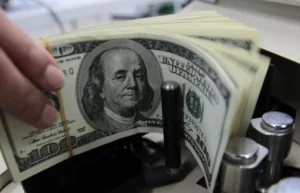On Tuesday, the US dollar fell to 4.9630 reais, a 0.38% drop. This move away from the 5.00 reais level aligns with global trends. Investors worldwide turned to riskier assets.
This shift came after signs that the Federal Reserve might postpone cutting rates. The dollar’s slight rise of 0.50% in February contrasts with this drop.
At the B3 exchange, futures dipped by 0.53%, settling at 4.9705 reais by late afternoon.
Lower Treasury yields influenced the dollar’s fall. It impacted its standing against other currencies too.
During the day, the dollar varied. It peaked at 4.9820 reais and dropped to 4.9514 reais at its lowest.

Analysts saw this as a market correction. Investors chased riskier options, moving away from recent negativity.
Recent Fed decisions had boosted the dollar, creating market gloom, explained Felipe Izac from Nexgen Capital.
Fed Chairman Powell’s caution on early rate cuts cooled enthusiasm.
Yet, Tuesday brought optimism. People sought out real and other high-risk options.
Remarks by the Fed’s Loretta Mester hinted at potential rate cuts if the US economy stays on track.
However, she hasn’t set a timeline for easing monetary policy. The dollar’s step back from Monday’s 5.00 reais high was notable.
Alexandre Espirito Santo of Way Investments thought the market had overreacted before. He suggested that more realistic levels would be around 4.85 to 4.90 reais.
Market Correction and Central Bank Policy in Brazil
The market is correcting early-year pessimism. Dollar and stocks are rebounding, showing the initial reaction was perhaps too strong.
The dollar also fell against major and emerging market currencies by late afternoon. The dollar index, showing its strength against six currencies, was down by 0.26%.
Brazil’s own monetary policy minutes got less attention.
The Central Bank’s Committee noted domestic progress but advised cautious policy due to global uncertainty.
It stressed the need for firm measures to anchor inflation expectations.
The Central Bank had also rolled over 16,000 swap contracts that morning.
This action, among others, reflects ongoing efforts to manage currency stability and inflation, which are essential for economic health and investment decisions.
In short, global finance interconnects policy, sentiment, indicators, shaping currency. Understanding aids in grasping broader economic trends.

